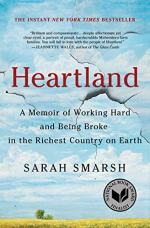|
This section contains 726 words (approx. 2 pages at 400 words per page) |

|
Heartland Summary & Study Guide Description
Heartland Summary & Study Guide includes comprehensive information and analysis to help you understand the book. This study guide contains the following sections:
This detailed literature summary also contains Topics for Discussion on Heartland by Sarah Smarsh.
The following version of this book was used to create this study guide: Smarsh, Sarah. Heartland. Scribner, an imprint of Simon and Schuster, 2018.
The narrative unfolds in second-person narration, with the author addressing the reader as though she or he was the child the author always imagined she would have. Following a brief authorial note, the author introduces this convention, or narrative technique, with a chapter addressing this imagined child, whom she has given the name “August.” Throughout this analysis, references to “August” will appear in quotation marks, to reinforce for the reader the sense of how this particular stylistic choice by the author fits into the rest of the narrative.
The narrative that comes after these two introductory sections follows a roughly chronological pattern. The first few chapters focus on the author’s experiences as a child in Kansas, a state in America that is part of what is often described as the Great Plains. As she describes it, her life there was spent moving from place to place, from country to city, from parent-figure to parent figure. Everywhere she went, and no matter the mother-figure with whom she lived, the focus always remained on farming and farm life. The latter chapters focus on the author’s later life, her high school and college years, also in America and for the most part also in Kansas. As she describes it, her life at that point was defined by a degree of settling in one place, and by coming to terms with the tensions between the life she used to live and the life that was both possible and present for her.
In the final chapter, the author describes events and experiences associated with her having achieved a significant degree of personal and professional success. This, she goes on to suggest, was the set of circumstances that made it possible for her to no longer define her life in terms of what she did not want the life of her imagined child to become. She had, as she describes it, achieved what the so-called American Dream suggested she could achieve, but which she also describes as something that her childhood and family history suggested was virtually impossible to achieve.
Within that larger chronological pattern, and within the framework of her consideration of her experience of the American Dream, the author frequently shifts her focus onto her family’s history. That history, as the author portrays it, is defined by two main factors. The first is the fact that the family lived lives defined by the hard work and sacrifices necessary to run a family farm in America. It is important to note that most of the author’s contemplation of this facet of her family’s history is associated with the America of the 1970’s and 1980’s, the years in which she was a child. She pays particular attention to the political, economic, and cultural consequences associated with governmental and economic policies of the time, a period associated with the pesidency of Ronald Reagan.
The second factor that defines her family’s history relates to the experiences of its women, specifically the author’s mother, grandmothers, and great-grandmothers. The author focuses mostly on the women to whom she had the most immediate connection, her mother Jeannie and maternal grandmother Betty. She considers, at length, how the experiences of both women were primarily defined by both the specific attitudes of the farming men in their lives and by the socio-cultural perspectives on women at the time. She relates the experiences of these two women to her own experience, that of her imagined daughter, and those of the women in her family who came before.
As she develops both these points of focus, the author repeatedly directs her storytelling and her contemplations towards her imagined daughter. There is a sense throughout the book that she is describing the life and circumstances that she did not want “August” to grow into. By the end of the book, there is the sense that she feels she has succeeded in this goal. She concludes by suggesting that as a result of everything she (the author) has done and come to understand, “August” has the potential to truly become what the American Dream has traditionally said she can become, fully free and living a life of unconditional hope and possibility.
Read more from the Study Guide
|
This section contains 726 words (approx. 2 pages at 400 words per page) |

|



